
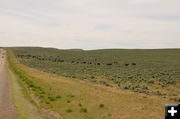
Moving cattle
In the spring, cattle are moved up the cattle trail to the summer patures on the Bridger-Teton National Forest.
|

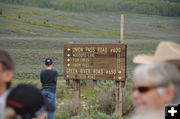
Upper Green
The cattle are taken to summer pasture in the Upper Green.
|

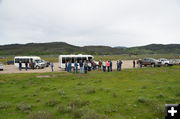
Bus tour
The Sublette County Historic Preservation Board rented two busses to take people to see the Drift. Others followed along in a car caravan that went north into the Upper Green on the Bridger-Teton National Forest.
|

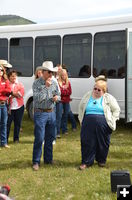
Tour guides
Ranchers Charles Price and Jonita Sommers led the two tour buses and gave information about the Drift.
|

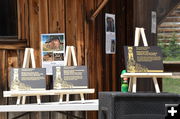
National Register Plaques
Three National Register listings were celebrated: The Green River Drift listing as a Traditional Cultural Property, the 1911 steel truss bridge over the Green River, and the Sommers Ranch headquarters historic district.
|

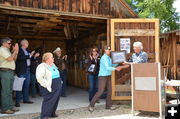
Thanking Laura
Laura Nowlin wrote the Green River Drift National Register nomination.
|

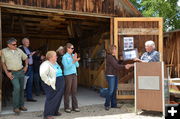
Thanking Mary
Mary Hopkins is the Wyoming State Historic Preservation Officer working at the State Historic Preservation Office.
|

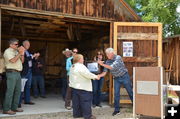
Thanking Jonita
Clint Gilchrist, President of the Sublette County Historic Preservation Board (CLG) gives Jonita Sommers recognition for her efforts to preserve the history of the Drift.
|

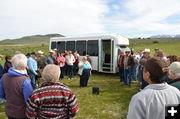
Jonita Sommers
Jonita Sommers led the Green River Drift tour. She provided much of the research information for the National Regiter nomination. Her family has been involved with the Drift for generations.
|
|
Dedication held for Green River Drift listing on National Register
by Joy Ufford, Photos by Terry Allen
June 26, 2014
Humans and herd animals share an instinct to move beyond boundaries, and both create trails where signs of their passages more than a century ago and to this day revealed their potential as modern legacies of Sublette County’s history and heritage.
On Friday, June 20 a dedication was held to celebrate the century-plus-old Green River Drift cattle trail, a 58-mile-long stock driveway from the desert to the mountains for summer grazing in the Upper Green River Valley of western Wyoming.
The Green River Drift’s first recorded use was in 1896 by the Upper Green River Cattle Association. Its members gathered their cattle in the spring on dry desert pastures and slowly moved them north.
The route follows the Upper Green River north, with splits and spurs helping cowboys move herds to summer pastures along the eastern Gros Ventre Range. In fall, cattle will "drift" back south leaving the mountains with cooler weather. Ranchers and cowboys still work their cattle out along the stock driveway and send them on their way to the home ranches.
As it goes with humans and herds, this annual migration is well-engrained in both species, basically unchanged in the past century, with the exception of snug cow camps, horse trailers and technological tools.
A lengthy process beginning in Sublette County and traveling to Washington, D.C., culminated with the Drift’s nomination to the National Register of Historic Places approved in November 2013. June 20 brought its dedication as the nation’s first-ever ranching-related "Traditional Cultural Property," or TCP. The dedication coincided with the Association’s first day of "turn-out," allowing visitors to watch the historic cattle move first-hand.
"We’re trailing them up the drift," explained rancher Charles Price. "If we really had to push at these cattle we’d never get up there. This is more like a migration than a ‘drive.’ A lot of these old cows know exactly where they’re going and they’re ready to go there."
Dedication events
A morning tour took 80 people from the sorting grounds at Trappers Point (by Highway 191 west of Pinedale) north to Cora and on up to Bridger-Teton National Forest (BTNF) along the Drift’s route. The next day, a group of 30 traveled the southern portion.
The driveway was protected lately by Sublette officials from development and crosses private and, Bureau of Land Management (BLM) and BTNF easements and highway right-of-ways. Association members have BTNF grazing permits on the Upper Green’s 100,000-acre allotment; nearby ranchers with allotments "off to the side" use the driveway, as do bikers, hikers, riders, snowmobilers and migrating wildlife.
The Drift’s farthest reaches extend across the mountains to Union Pass, west of Dubois.
"You can go 32 miles and still be on this allotment," Price said.
Each pasture system has a newer log cabin where riders are based to put out salt blocks, doctor cattle, disperse cattle from riparian areas, fix fence – and one new duty accompanying grizzlies and wolves frequenting the Upper Green.
"As predators have moved up into this area there’s a lot more searching for predator kills," said Price, also on the Wyoming Game and Fish Commission.
Bringing the Green River Drift into its current prominence took a huge collaboration among Sublette ranchers, officials, historians and volunteers, progressing from an idea sparked by Jonita Sommers and the Sublette County Historic Preservation Board (SCHPB) into reality with support from the Upper Green River Cattle Association, Wyoming Stockgrowers Association (WSGA), Wyoming Cultural Trust Fund, Sublette County and Wyoming agencies and BLM, FS and National Park Service.
After the tour, 225 people converged at the Sommers Ranch and Homestead (listed on the National Register in 2009) to be welcomed by owners Albert Sommers (Wyoming HD-20 representative) and his sister, Jonita Sommers with a barbecue lunch and an ample supply of mosquito spray.
Speakers explained why the Drift’s acceptance as a TCP is unique and historic.
"This is a living representation of our community’s heritage," said SCHPB chair Clint Gilchrist. He joked that if people driving along its route have cattle cross in front of them, "you are officially part of ‘the Drift.’"
Gilchrist then introduced Wyoming BLM Director Don Simpson. Wyoming’s ranching traditions, policy recognition of ranching as an important multiple use and the Green River Drift’s status as the oldest continuously used stock driveway were important reasons for the BLM to support the nomination process, Simpson said.
The BLM became a federal agency in the 1940s and has a "rich history" with working with ranchers, he said.
Don Simpson, director of the Wyoming BLM, cited the "most notable" aspect of the Drift’s nomination is the "sense of community and sense of partnerships" that show people’s love of the land and heritage.
"It’s a huge effort and a lot of painstaking research that goes into making one of these nominations," he said. "This is one of the things that makes my job worthwhile – for this to be the first cultural property (TCP) associated with ranching in the country. That’s something to be proud of." Also noteworthy is the collaboration among groups and individuals that might not always see eye to eye, he said. "But we’re a place that knows how to work through our conflicts toward a goal."
Mary Hopkins, the department’s historic preservation officer, called the process "a labor love." She also spoke of working with federal-level agencies for the National Register process, including the federal Advisory Council on Historic Preservation, the Federal Highway Administration and the National Park Service.
Encompassing 7,000 acres, the Green River Drift is one of the larger properties as a National Register TCP, Hopkins said. "It’s an interesting and remarkable property in so many ways."
Speaker Jose Castro, BTNF acting supervisor, also called the Drift’s tradition "living history … that mimics the movements of ancient hunters and wildlife centuries ago. … I think this will be a classic textbook study for new similar projects in the future."
Speakers shared their experiences with the cooperation they found at every level. Albert and Jonita discussed why it is so important to support the Green River Drift TCP nomination that led to the dedication being celebrated that day at their ranch, where the family’s preservation efforts led to the renovation of the Sommers Ranch Homestead cabin and outlying buildings being presented to the public as a living history museum.
Sommers, still dressed in his battered cowboy hat and spurred boots from the morning’s cattle turn-out, thanked the many offices, agencies, landowners and volunteers for helping protect the Green River Drift. "Our families have moved cattle of this drift for more than 100 years," he said, creating strong bonds among Association ranchers for generations.
Jonita, honored for her tireless determination, gave some of the history behind the Green River Drift to its present-day use.
Peeking over the podium, Sommers waved a sheaf of papers. "Well, Albert wrote my speech," she said. "I think he wanted to control his sister’s speech."
She interspersed history with stories passed down through the years.
The Drift’s first written use was in 1896, she said, and the route ran from near Fontenelle Creek north along the Green River to the Gros Ventres’ summer pasture. At that time, it was an open range without fences and many ranchers drove their cattle north. The U.S. Forest Service, created in 1905, asked ranchers to form grazing associations and forest grazing permits were issued in 1906.
Ranchers still moved their cattle across the Mesa (much of it now occupied by the Pinedale Anticline energy development) to the sorting grounds, with the closest herds moving north first. At the southern end, some ranchers such as the Espenscheids and mainly the Murdock family still use the historic Cattle Bridge near the Little Colorado Desert, built in 1946 by Harry Steele, now 93.
"The path has moved slightly, but it’s never without cattle," Sommers said.
The cattle are turned out in stages and move easily up the drift the first day to water at Marsh Creek, where Forty Rod Road meets Highway 352 above Cora. There the drift widens and cows and calves, yearlings and bulls spread out to rest, graze and water before being moved along again the next morning.
It takes three to four weeks for all of the cattle to arrive at their destinations – summer pastures. At the "counting gate," rancher and retired brand inspector Bob Beard reads off cattle brands and his granddaughters log them.
"Grazing is one of the oldest uses of the land," Jonita said.
"This was a groundbreaking nomination," Gilchrist said. "This was a very difficult thing to do."
The final speaker was WSGA Executive Vice President Jim Magagna, who reminded everyone present that the Green River Drift represents history that is still alive, basically unchanged for more than a century.
"I want to congratulate the people of Sublette County and all those people who worked so hard over the years," Magagna said of the TCP nomination and dedication.
"We’re celebrating the history … a living-history monument," Magagna said. "But let’s all dedicate ourselves to the future."
The cattle industry today faces many changes and challenges for ranchers to understand, which is more complicated than a century ago. Fortunately, the Drift will be preserved as a tradition. For the cattle that "drift" north each summer and south toward home when the weather turns, it’s an annual ritual and business as usual.
"A cow today – her thoughts are no different than the cow’s thoughts that walked up that trail 100 years ago," Magagna said.
Photos by Terry Allen
|